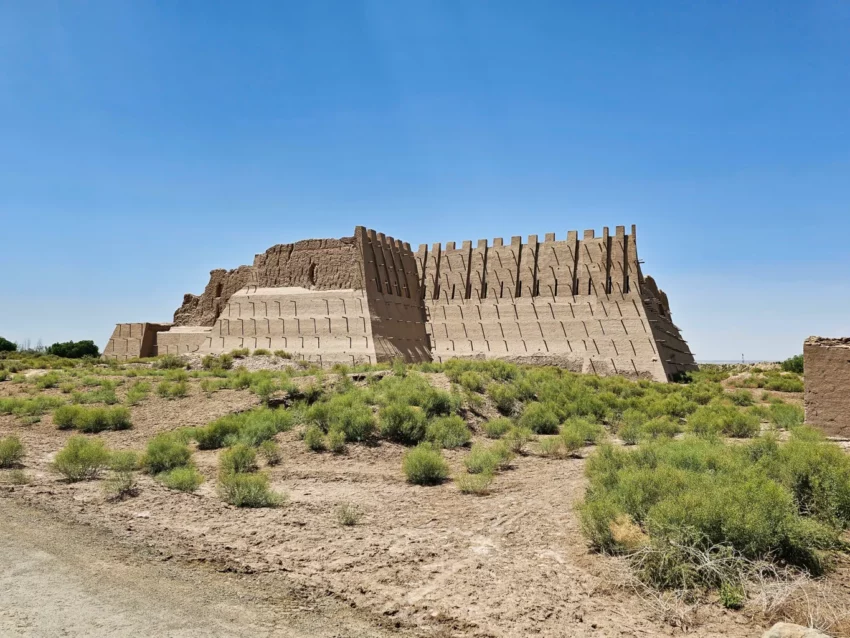Kyzyl Kala Fortress, nestled in the Karakalpakstan region of Uzbekistan, is a remnant of ancient fortification. This red-brick structure dates back to the Kushan Empire, around the 2nd to 4th centuries AD. It stands as a testament to the architectural prowess and strategic importance of the region during the Silk Road era. The fort’s discovery and subsequent excavations have provided valuable insights into the Kushan civilization and their interactions with other cultures.
Get your dose of History via Email
Historical Background of Fort Kyzyl Kala
Archaeologists stumbled upon Fort Kyzyl Kala during the 1930s. The fort’s origins trace back to the Kushan Empire, a major power in Central Asia. The Kushans built it, and it served as a military stronghold. Over time, different groups inhabited the fort. It witnessed significant historical events, including trade and conflicts along the Silk Road. The fort’s strategic location made it a hub for cultural exchanges and military activities.
The Kushan Empire, known for its syncretism, left a lasting impact on the region. They facilitated the spread of Buddhism and trade. Fort Kyzyl Kala, as part of this empire, played a crucial role. It provided protection and control over the surrounding territories. The fort’s robust construction ensured its survival through the ages. It stands as a silent witness to the ebb and flow of empires and civilizations.
Later inhabitants left their mark on the fort. They adapted it to their needs, reflecting the changing times. The fort’s walls have seen the rise and fall of many, from local chieftains to invading forces. Its history is a mosaic of cultures and epochs, each adding a layer to its story. The fort’s significance extends beyond its military use. It was a cultural and economic center, influencing the region’s development.
Fort Kyzyl Kala’s location was no accident. It was at the crossroads of several important trade routes. This position made it a key player in regional politics and commerce. The fort’s design and construction techniques also reflect the ingenuity of its builders. They created a stronghold that could withstand the harsh desert climate and potential invaders. The fort’s endurance is a tribute to their skills.
Excavations at Fort Kyzyl Kala have unearthed artifacts and structures. These findings offer a glimpse into the daily life of its inhabitants. The fort’s history is not just about battles and conquests. It’s also about the people who lived, worked, and traded within its walls. The ongoing research at the site continues to unravel the fort’s mysteries, enriching our understanding of the past.
About Fort Kyzyl Kala
Fort Kyzyl Kala’s architecture is a marvel of ancient engineering. The fort’s red bricks give it a distinctive appearance, hence its name, which means “red fortress” in Turkic languages. The rectangular layout of the fort, with rounded corners, was a strategic design choice. It maximized defense capabilities while providing a spacious interior for its occupants.
The fort’s walls, some reaching up to 8 meters in height, were a formidable barrier against invaders. The use of mud bricks, a common building material in the region, was both practical and effective. These bricks provided insulation against the extreme temperatures of the desert. They also allowed for quick and efficient construction and repair.
Inside the fort, the remains of rooms and corridors suggest a well-planned internal structure. The layout was likely designed to accommodate both military and civilian needs. The presence of administrative buildings, living quarters, and storage facilities indicates a self-sufficient community. The fort’s inhabitants could sustain themselves during prolonged sieges or periods of isolation.
Architectural highlights of Fort Kyzyl Kala include its towers and gates. These features not only enhanced the fort’s defensive capabilities but also demonstrated the builders’ attention to detail. The towers provided vantage points for surveillance and defense. The gates, intricately designed, served as both entry points and potential chokepoints for unwelcome visitors.
The construction methods of Fort Kyzyl Kala reveal a blend of local traditions and foreign influences. The fort’s builders utilized techniques that were advanced for their time. They created a structure that has endured for centuries. Today, the fort’s ruins continue to attract scholars and tourists alike. They come to admire its historical significance and architectural beauty.
Theories and Interpretations
Fort Kyzyl Kala has sparked various theories regarding its purpose and history. Some scholars believe it was primarily a military outpost. Others argue it was a trading center. The truth likely lies somewhere in between. The fort’s strategic location suggests it served multiple functions, adapting to the needs of its inhabitants over time.
The mysteries of Fort Kyzyl Kala extend to its sudden abandonment. There is no clear consensus on why it was deserted. Some theories point to a change in trade routes. Others suggest a natural disaster or military defeat. The lack of definitive evidence means that the fort’s final days remain a subject of speculation.
Interpretations of the fort’s structures and artifacts have had to rely on historical records. These records, however, are often incomplete or ambiguous. Archaeologists have pieced together a narrative that fits the available evidence. Yet, many aspects of the fort’s story are still open to interpretation.
Dating the fort has been a challenge. Radiocarbon dating and stratigraphy have provided some answers. These methods suggest the fort was in use from the 2nd to the 4th centuries AD. However, the accuracy of these dates is subject to the limitations of the techniques and the context of the samples.
The fort’s role in the broader history of the region is a topic of ongoing research. Its connections to other sites along the Silk Road are particularly intriguing. Fort Kyzyl Kala may have been part of a network of fortifications. These forts could have provided security and support for the caravans that traversed Central Asia.
At a glance
Country: Uzbekistan
Civilization: Kushan Empire
Age: 2nd to 4th centuries AD

